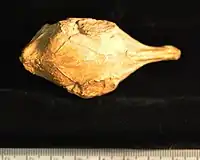Hypisodus
Hypisodus is an extinct genus belonging to the family Hypertragulidae, within the order Artiodactyla, endemic to North America during the Eocene through Oligocene, living 37.2–26.3 Ma, existing for approximately 10.9 million years .[2]
| Hypisodus | |
|---|---|
 | |
| Hypisodus retallacki from the Oligocene (Orellan) Cedar Creek Formation in Horsetail Creek, Colorado. | |
| Scientific classification | |
| Kingdom: | Animalia |
| Phylum: | Chordata |
| Class: | Mammalia |
| Order: | Artiodactyla |
| Family: | †Hypertragulidae |
| Genus: | †Hypisodus Cope (1873) |

Hypisodus retallacki skull; same specimen as in the taxobox but in anterior view showing narrow snout. Cast in University of Colorado Museum, Boulder (39032) of original in University of Wyoming Museum, Laramie (13933) [1]
Hypisodus were primitive and ancient ruminants, resembling small deer or musk deer, although they were more closely related to modern chevrotains. Its diet is stated to be that of a frugivore.
Taxonomy
Hypisodus was named by Cope (1873). It was assigned to Hypisodontinae by Matthew (1908); and to Hypertragulidae by Cope (1873), Cook (1934) and Carroll (1988).[3][4]
Fossil distribution
Partial list of fossil sites:
- 10 N Site, Gallatin County, Montana
- Horsetail Creek, Logan County, Colorado
References
- Meehan, T.J.; Martin L.D. (2004). "Emended description and a new species of Hypisodus (Artiodactyla: Ruminantia, Hypertragulidae)". New Mexico Museum of Natural History Bulletin. 26: 137–141.
- PaleoBiology Database: Hypisodus, basic info
- W. D. Matthew. 1908. Osteology of Blastomeryx and phylogeny of the American Cervidae. Bulletin of the American Museum of Natural History 24(27):535-562
- H. J. Cook. 1934. New artiodactyls from the Oligocene and Lower Miocene of Nebraska. American Midland Naturalist 15(2):148–165
This article is issued from Wikipedia. The text is licensed under Creative Commons - Attribution - Sharealike. Additional terms may apply for the media files.